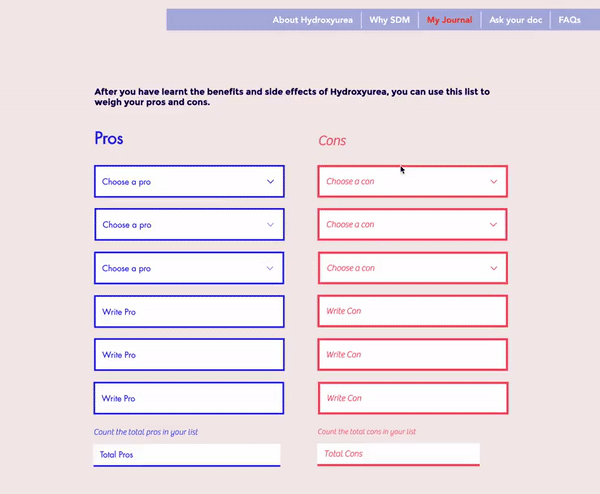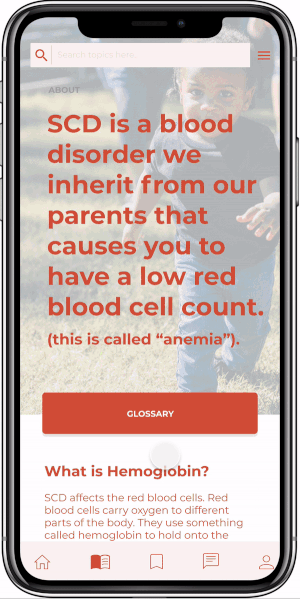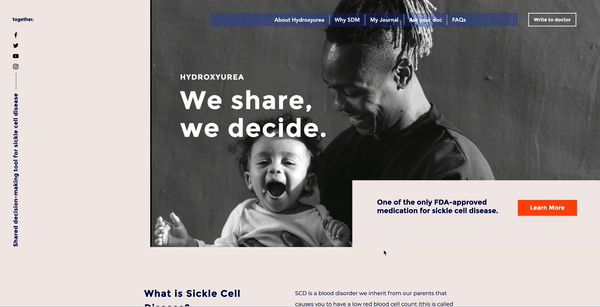THE CHALLENGE
Design a strategy to engage stakeholders of sickle cell disease to cope with everyday life.

Skip to a section here:
Background
What is Sickle-Cell Disease (SCD)?

SCD is a blood disorder we inherit from our parents that causes you to have a low red blood cell count (this is called “anemia”). SCD affects the red blood cells. Red blood cells carry oxygen to different parts of the body. They use something called hemoglobin to hold onto the oxygen. People with SCD have a type of hemoglobin called hemoglobin S. Hemoglobin S causes red blood cells to become hard, sticky or “sickle” (half-moon) shaped.

What is Hydroxyurea (HU)?
/hi-drok-see-yoo-ree-uh/
Hydroxyurea is an oral medicine that can lessen many clinical problems (pain, number of blood transfusions, hospitalizations) for patients with SCD.

UX Research
The task was to design a multi-media strategy for disseminating newly learnt information about:
1. Hydroxyurea (HU)
2. Shared decision Making (SDM)
2. SDM for HU
IDENTIFYING GOALS




I plotted the unique needs of each user in the framework pictured on the right.
I broke down the needs into individual short-goals and sampled the messaging or 'voice' for each goal. This helped me narrow down the features each goal requires, which informed the decision of which kind of medium to adopt.
The types of media that emerged from this exercise were derived by their function of providing static information or dynamic interaction capabilities.
.png)
USER STORIES
The user story of the patient and doctor was articulated in a consistent template:
As a ............, I want to ......... so that ............

ECOSYSTEM MAP
The user goals were plotted on a content interaction matrix to visualise how each user groups interacts with the content.
Patients/parents and doctors emerged at the shared position of contributors to and consumers of dynamic information.
.png)

USER JOURNEY
I used Miro to create the user flow for both the key users. The flow captures the top-level journey a user undertakes to learn about SDM. It also depicts the interaction required between the two users.


Prototyping
WEBSITE 1: SHARED DECISION MAKING FOR HYDROXYUREA
FOR: PATIENTS/PARENTS/FAMILY
MADE ON: WIX
The core functions for the patients were to learn about Hydroxyurea and feel empowered to take the decision with their doctor. To further help with making a decision, there is a journal which includes an interactive pros and cons list where the patients can assess the risks and share this list with their doctors in the next consulation.
Key features:
1. Learn about Hydroxyurea
2. Make a decision
3. Interact with doctor









MOBILE APPLICATION: ABOUT HYDROXYUREA
FOR: PATIENTS/PARENTS/FAMILY
MADE ON: FIGMA
An in-depth learning platform for patients, parents of patients, friends and family to study latest news and information about hydroxyurea.
Key features:
1. Detailed learning modules
2. Saving information to collection
3. Benefits and risks













The Sickle Cell Disease Association of America organised its 47th Annual National Convention in Baltimore in October 2019.
In an effort to advocate for improved quality of life for individuals and families affected with SCD, it saw participation from patients, family members, doctors, clinicians, community organisations, including other stakeholders.
Usability Workshop
I designed and facilitated a usability testing workshop with the stakeholders of sickle cell disease at the conference.
They were divided into 3 groups:
Doctors/hematologists/clinicians
Patients/parents
Family/community


The methodology included 3 activities in the following order:
ACTIVITY 1: BLINK TEST
Show the homepage for five seconds and ask the participants to write the first 3 elements that stood out to them. This is done to test the efficiency of the key messaging of a tool.
In this case, several participants wrote words describing how they felt when they saw the page.




.png)

_edited.jpg)
.jpg)
ACTIVITY 2: CARD SORTING
Each participant was given a set of shuffled cards (post-it notes) with different categories of content. Each group was asked to use the cards and add their own titles to build a unique learning path suitable for their user group.
Key insights:
1. Patients/parents saw the journey as non-linear with parallel tasks.
2. Patients/parents added Self Advocacy as the #1 topic they wanted to learn about.
3. Patients/parents unanimously voted 'write to doctor' out of their list, as they said it had been invaluable in the past.
4. Community members added 'pre-success stories' or process stories to their list.
5. Doctors created the most concise list of 8 topics they wanted to study in a linear fashion.
%20(1).jpg)


ACTIVITY 3: SCENARIOS & TASKS
To identify roadblocks in going from point A to B, participants were given scenarios cards with tasks on them. Each task tested the usability of a particular key feature of the tool.
-
1-2 participants navigated the task
-
1 participant kept record of time
-
1 participant ket record of the number of steps
-
Facilitator kept record of any roadblocks, observations, insights, questions, etc.
-
The test was audio and screen-recorded for analysis

I conducted the workshop with the help of two co-facilitators: Dr. Lori Crosby and Yolanda Johnson. The steps for facilitation were detailed in the protocol.
Click here to read the facilitator's copy
of the protocol and agenda.



RESULTS
Three tools are in development for the dissemination of the latest Sickle Cell Disease-related information. The feedback from the usability workshop is being incorporated into the design of the tools.
Analog tools are being developed parallelly for engagement of stakeholders at multiple touchpoints.
Click here to read the feedback summary.


